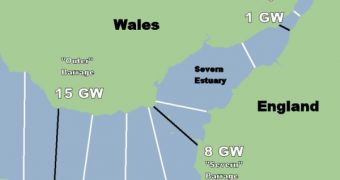The United Kingdom currently debates the faith of one of the most ambitious water projects in the world, the 20 billion pound- ($28 billion-) Severn barrage, which is to stretch for a whooping 10 miles (16 kilometers), between Lavernock Point near Cardiff and Brean Down near Weston-super-Mare. The giant tidal wave power plant is bound to harness the power of the waves, to produce approximately 5 percent of the island nation's electricity requirements. However, the problem is that the barrage will block the Severn Estuary, which is home to thousands of species of birds, and is also used by migrating fish to get up river, where their spawning grounds are.
Currently, the implications of the project are being carefully assessed, but the situation is pretty tricky, experts say, as those who need to make a decision have to weigh between two green issues, one that eliminates the need for eight regular coal-fired power stations, and the other that advocates the necessity to save thousands of animal species.
In addition to destroying large areas of mudflats and mashes, the project is also criticized for channeling all the funds allocated to renewable energy in a single place, instead of spreading it on other options as well, such as wind or solar power. Basically, environmentalists say, the British people is presented with the scepter of the largest destruction of a natural habitat the country has ever encountered, or will encounter in the near future.
"The Severn Estuary contains nearly 90 per cent of the tidal range resources of the UK, so for the Government not to consider a barrage seriously would not look like leadership over climate change," Andrew Lee, the chief executive of the Sustainable Development Commission (SDC), the official green advisor for the government, explains.
However, he adds that two conditions need to be met in order for the project to move along. First of all, its ownership has to stay in public hands, and secondly, it has to propose the construction of new habitats, to accommodate the animals that will be displaced once the massive barrage is constructed. Lee also states that the height difference between te high and low tides can reach 45 feet (15 meters), which makes it extremely valuable for green energy production, at an estimated 8 gigawatts of power.
"The final scheme must be the one that generates as much clean energy as possible, while minimising harm to the estuary and its wildlife. We know the Cardiff-Weston Barrage would destroy huge areas of estuary marsh and mudflats used by 69,000 birds each winter and block the migration routes of countless fish," the head of sustainable development for the Royal Society for the Protection of Birds (RSPB), Martin Harper, maintains.

 14 DAY TRIAL //
14 DAY TRIAL //